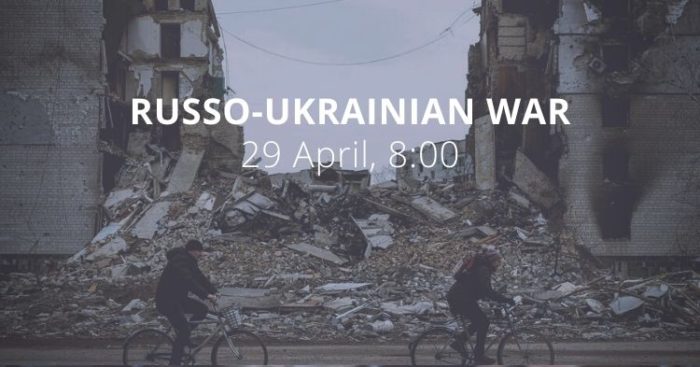Russian forces conducted massive missile strikes across Ukraine for two days in a row. 23 killed and 100 injured on October 10 as a result of Russian massive strikes on Ukraine. Ukrainian forces continued to conduct counteroffensives east of the Oskil River and in the direction of Kreminna-Svatove. Ukrainian troops continued ground attacks in northern and western Kherson Oblast. Russian forces continued to conduct ground assaults in Donetsk Oblast. More explosions in Crimea reported. Russian and occupation administration officials continue to conduct filtration activities in Russian-occupied territories.
Daily overview — Summary report, October 12
A map of the approximate situation on the ground in Ukraine as of 00:00 UTC 12/10/22.
There have been no notable changes to control since the last update. pic.twitter.com/zak6RA9TBq
— War Mapper (@War_Mapper) October 12, 2022
The General Staff’s operational update regarding the Russian invasion as of 06.00 am, October 12, 2022 is in the dropdown menu below
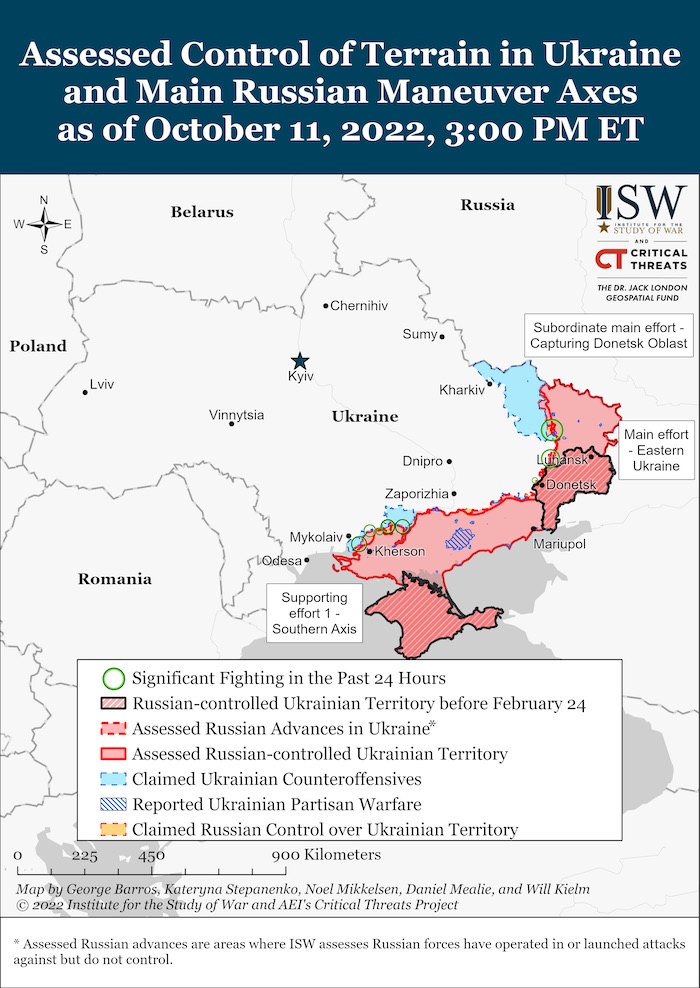
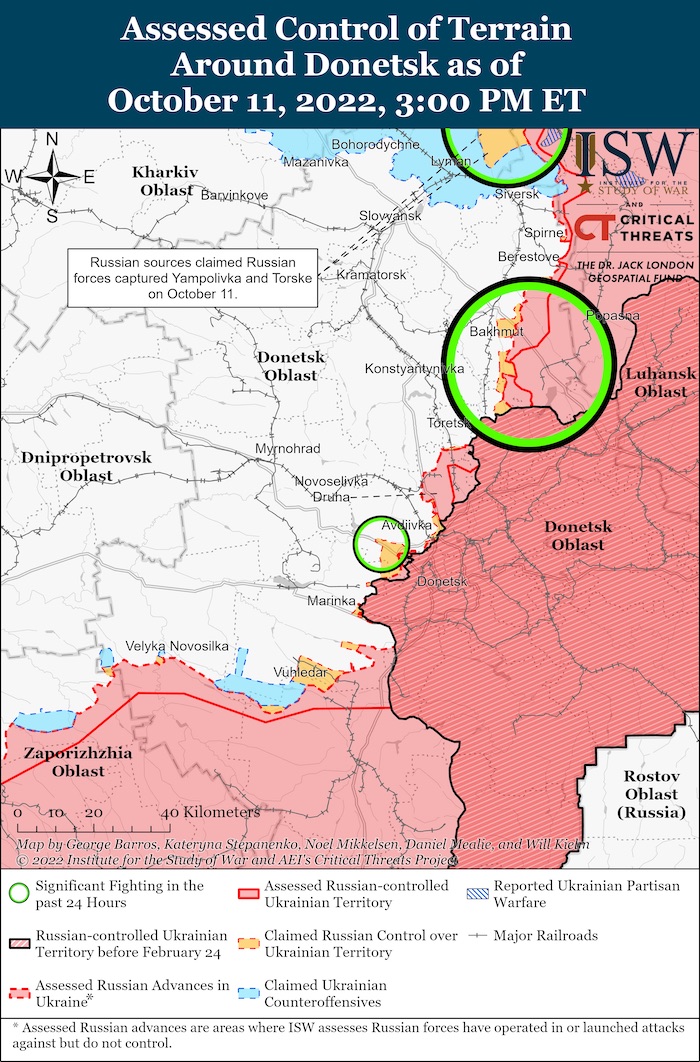
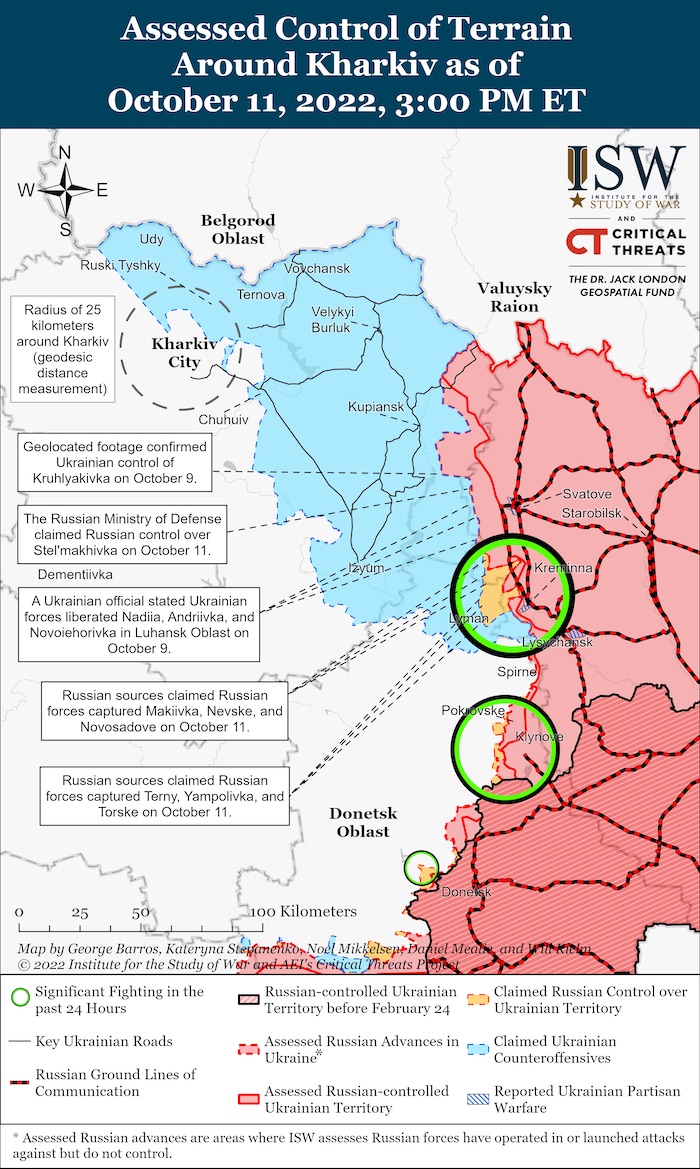
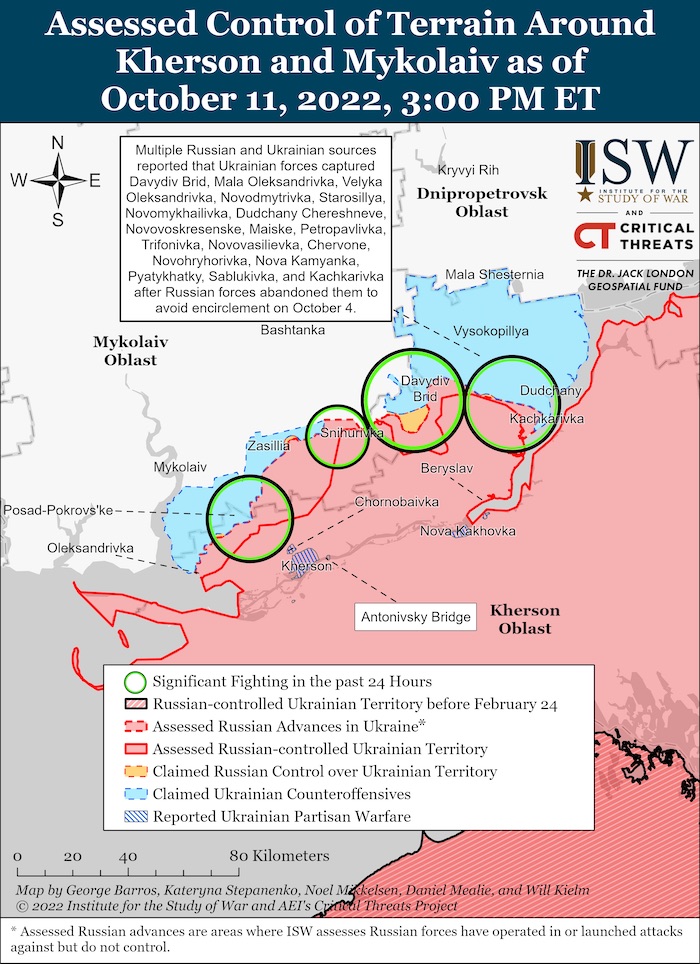
Military Updates
Air defense forces shot down 18 cruise missiles, 8 Iranian drones in the south and 3 drones, said Yuriy Ignat, spokesman for the command of the Air Force of the Armed Forces of Ukraine.
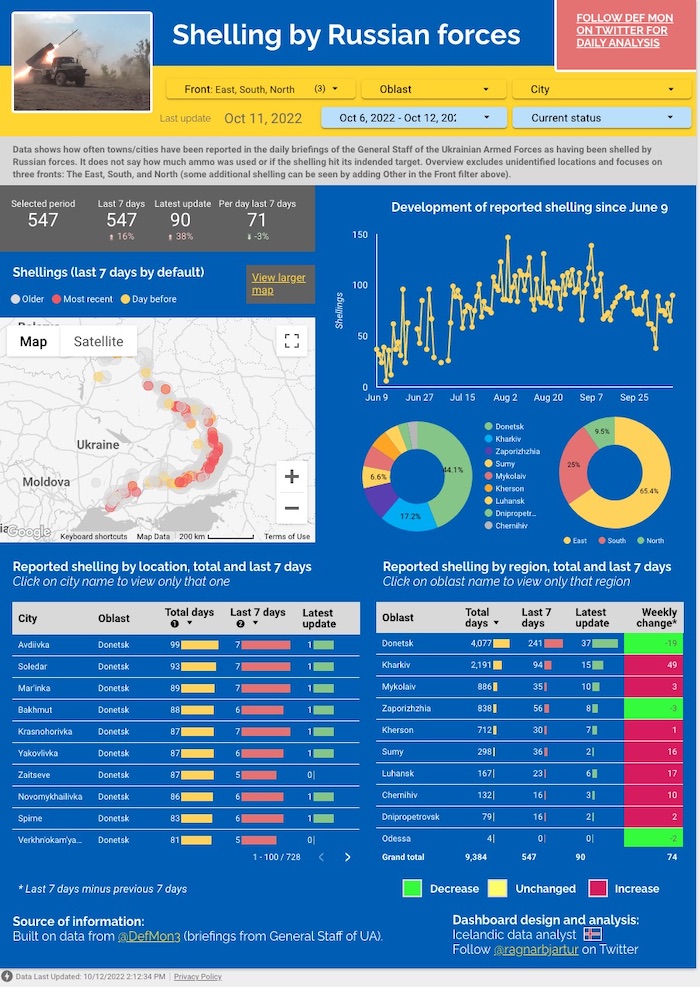
Additional 4 HIMARS from the United States arrived in Ukraine, said Minister of Defense of Ukraine Oleksiy Reznikov.
https://twitter.com/EuromaidanPress/status/1579948059353845761
NATO has not yet seen signs of Russia preparing for the possible use of nuclear weapons, said the head of the Alliance Stoltenberg. He also added that NATO had clearly conveyed to Russia that the consequences would be most serious if Russia uses nuclear weapons in any context, including in Ukraine.
https://twitter.com/EuromaidanPress/status/1579931258142220288
Belarus transfers tanks, ammunition, and air defense systems to Russia. Several new echelons with equipment of the Armed Forces of the Republic of Belarus headed in the direction of the Russian Federation, according to Belaruska Gayun. From Minsk towards Borisov, a train with at least 8 T-72A tanks was seen (eyewitnesses report 15-30 tanks), and at least 28 Ural trucks. Another echelon was seen in Orsha. Two UAZs, 5 MAZs and 5 Tor-M2 air defense systems were also seen.
Regional Updates
In Kyiv, Vinnytsia, Chernihiv, Sumy, Ternopil, Cherkasy, Khmelnytskyi, Lviv, and Chernihiv Oblasts, planned power outages began.
Ukrainians are asked to limit light consumption in order to reduce the load on the electrical systems of Ukraine.
In Dnipropetrovsk Oblast, the Russian military used incendiary ammunition during the shelling of Nikopol.
https://twitter.com/EuromaidanPress/status/1580015400724504576
In Zaporizhzhia Oblast, as a result of the shelling of the city of Orekhov and the village Stepnoрorsk near Zaporizhzhia seven killed and seven injured. Orekhovo and its vicinity come under shelling every day during the distribution of humanitarian aid.
According to British Defence Intelligence, (last 48 hours):
https://twitter.com/DefenceHQ/status/1580128375984730112
- Russia has deployed Iranian-manufactured uncrewed aerial vehicles (UAVs) since at least August 2022, including the one-way attack Shahed-136 variant. Russia included Shahed variants among the extensive wave of strikes it conducted on 10 October 2022. Previously, the Ukrainian General Staff reported that Russia had launched a total of 86 Shahed-136s and claimed that 60 per cent had been destroyed in the air.
- These UAVs are slow and fly at low altitudes making lone aircraft easy to target using conventional air defenses. There is a realistic possibility that Russia has achieved some success by attacking with several UAVs at the same time.
- Despite a reported range of 2,500 km, the Shahed-136 only has a small explosive payload. It is unlikely to be satisfactorily fulfilling the deep strike function which Russia probably aspired to use it for. With Russian tactical combat jets still achieving limited effect over Ukrainian territory, the lack of a reliable, sustainable, and accurate operational-level strike capability is likely one of Russia’s most significant capability gaps in Ukraine.
Losses of the Russian army
As of 11 October, the approximate losses of weapons and military equipment of the Russian Armed Forces from the beginning of the war to the present day:
⚰️russia's combat losses in Ukraine as of October 12
▪ 63380 killed soldiers (+270)
▪ 5181 APV (+19)
▪ 2505 tanks (+1)
▪ 1507 artillery systems (+11)
▪ 268 aircraft and 235 helicopters
▪ 15 boats and cutters#StopRussia #StandWithUkraine pic.twitter.com/HinaXCkppt— VoxUkraine (@voxukraine) October 12, 2022
Humanitarian
23 killed and 100 injured on October 10 as a result of Russian massive strikes on Ukraine.
Ukraine finds Russia's torture chamber near centuries-old monastery Sviatohirsk Lavra in Donetsk Oblast
Russian soldiers detained local residents who supported Ukrainian integrity and forcibly hold them in a recreation facility - SBUhttps://t.co/13JGTkshBg pic.twitter.com/Go4ZS7x6uY
— Euromaidan Press (@EuromaidanPress) October 11, 2022
In the liberated Sviaatohorsk and Lyman, Ukrainian law enforcement officers discovered mass graves of civilians. An investigation has been launched.
https://twitter.com/EuromaidanPress/status/1579962548278829056
Ukraine returned 32 Ukrainian Pows and the body of a murdered Israeli citizen from captivity.
32 Ukrainian soldiers released from Russian captivity
Among the liberated are officers & sergeants. They were in places of fierce fighting, @AndriyYermak said. Ukraine has also managed to bring back the body of the Israeli citizen Dmytro Fialka https://t.co/tDoKV2udel pic.twitter.com/M4RWEzPOZJ
— Euromaidan Press (@EuromaidanPress) October 11, 2022
Environmental
Russia hit 30% of Ukraine's energy infrastructure over 2 days - energy minister Halushchenko
He said one of the reasons for Russia's largest-yet attack on energy infrastructure is that Ukrainian electricity helps European countries save on Russian gashttps://t.co/yLXBze3Exg
— Euromaidan Press (@EuromaidanPress) October 11, 2022
All six power units have been switched off at ZNPP, occupiers are forcing employees to sign contracts with Rosatom,
said Main Intelligence Directorate of the Ministry of Defense.
Russia continues strikes against Ukrainian energy facilities; air defense shoots down 20 missiles, 13 drones
Energy infrastructure objects were hit in Lviv, Vinnytsia Obl. Great damage was caused in Dnipro Obl; residents are called on to save powerhttps://t.co/qks2wQGBZV pic.twitter.com/4MG7ZbITTt
— Euromaidan Press (@EuromaidanPress) October 11, 2022
The Russian occupiers kidnapped and allegedly tortured Zaporizhzhia NPP deputy general director for personnel. Energoatom Valery Martynyuk was kidnapped yesterday. His whereabouts are still unknown.
https://twitter.com/EuromaidanPress/status/1579940752162926593
Legal
#Putin admits #Russia mass bombing of #Ukraine energy infrastructure, playgrounds and apartments was out of revenge #StandWithUkraine #RussiaWarCrimes #StopRussia #RussiaTerroristState #CrimeaBridgehttps://t.co/oIsuTiLNrQ pic.twitter.com/WlVjObVvwr
— Halya Coynash (@halyapuff) October 12, 2022
International Criminal Court to investigate Russia’s strikes on Ukraine
The law will ensure a day of reckoning in Ukraine for any bully, any individual with a gun or with a missile, @KarimKhanQC stressed - CNN https://t.co/TzzGwSpqRf pic.twitter.com/cD9Bo5W0JW
— Euromaidan Press (@EuromaidanPress) October 11, 2022
Support
https://twitter.com/EuromaidanPress/status/1579870640332746752
Canada to send 40 engineers to Poland to train the Ukrainian military, according to Canadian Defense Minister. Canadian instructors will train sappers for the Security Service of Ukraine in a number of engineering skills, engineering reconnaissance, and mine clearance.
The US to supply Ukraine with 8 NASAMS air defense systems. Two air defense systems will be delivered "in the very near future", and 6 more a little later.
New Developments
Ukrainians raise $9.6 mn for kamikaze drones after Russian missile strikes
Run by @prytula, the campaign to buy a Ukrainan-made RAM II UAV to avenge Russian attacks raise this sum over only 1 dayhttps://t.co/49CqVjBl2B pic.twitter.com/4KJfxfMUNb
— Euromaidan Press (@EuromaidanPress) October 12, 2022
The US is not looking for a conflict with Russia and will not send troops to Ukraine, the White House noted. The US does not want the war in Ukraine to acquire a nuclear dimension and sees no reason for this.
NATO will conduct exercises on nuclear deterrence next week, said NATO Secretary General Jens Stoltenberg.
https://twitter.com/EuromaidanPress/status/1579985448352481280
Zelenskyy proposed to place peacekeepers on the border of Ukraine with Belarus in his speech at the G7 summit.
https://twitter.com/EuromaidanPress/status/1579860384298958848
Assessment
- On the war.
The Institute for the Study of War has made the following assessment as of 11 October, 2022:
Russian forces conducted massive missile strikes across Ukraine for the second day in a row on October 11. The Ukrainian General Staff stated that Russian forces fired nearly 30 Kh-101 and Kh-55 cruise missiles from Tu-95 and Tu-160 strategic bombers and damaged critical infrastructure in Lviv, Vinnytsia, Dnipropetrovsk, Donetsk, and Zaporizhzhia oblasts.[1] Ukrainian air defense reportedly destroyed 21 cruise missiles and 11 unmanned aerial vehicles (UAVs).[2] Social media footage shows the aftermath of strikes throughout Ukraine.[3] Russian forces additionally continued to launch attacks on Ukrainian infrastructure with Iranian-made Shahed-136 drones.[4] The Ukrainian General Staff reported that Ukrainian air defense destroyed eight Shahed-136 drones in Mykolaiv Oblast on the night of October 10 and 11.[5]
Army General Sergey Surovikin’s previous experience as commander of Russian Armed Forces in Syria likely does not explain the massive wave of missile strikes across Ukraine over the past few days, nor does it signal a change in the trajectory of Russian capabilities or strategy in Ukraine. Ukraine’s Main Intelligence Directorate (GUR) representative, Andriy Yusov, linked the recent strikes to Surovikin’s appointment as theatre commander and stated on October 11 that “throwing rockets at civilian infrastructure objects” is consistent with Surovikin’s tactics in Syria.[6] However, Surovikin has been serving in Ukraine (as the Commander of the Russian Aerospace Forces and then reportedly of the southern grouping of Russian forces) since the beginning of the war, as have many senior Russian commanders similarly associated with Russian operations in Syria.[7] Army General Aleksandr Dvornikov, who was appointed in April to the role that Surovikin now holds, similarly commanded Russian forces in Syria between 2015-2016 and became known for deliberately and brutally targeting civilians.[8] Colonel General Aleksandr Chayko, the former commander of the Eastern Military District who took an active part in the first stages of the war in Ukraine, also served as Chief of Staff of Russian forces in Syria from 2015 and into 2016.[9] As ISW noted in April, all Russian military district, aerospace, and airborne commanders served at least one tour in Syria as either chief of staff or commander of Russian forces, and Russian forces deliberately targeted civilian infrastructure including hospitals and breadlines throughout the period of Russia’s active engagement in that war.[10] Disregard for international law and an enthusiasm for brutalizing civilian populations was standard operating procedure for Russian forces in Syria before, during, and after Surovikin’s tenure. It has become part of the Russian way of war.
Surovikin’s appointment will not lead to further “Syrianization” of Russian operations in Ukraine because the battlespace in Ukraine is fundamentally different from the battlespace in Syria, and direct comparisons to Surovikin’s Syrian “playbook” obfuscate the fact that Russia faces very different challenges in Ukraine. Russia cannot further “Syrianize” the war largely because of its failure to gain air superiority, which precludes its ability to launch the kind of massive carpet-bombing campaigns across Ukraine that it could, and did, conduct in Syria. ISW has previously assessed that Russian air operations would have been markedly different if conducted in contested airspace or a more challenging air-defense environment, as is the case in Ukraine.[11] It is therefore highly unlikely that Surovikin’s role as theatre commander will cause a fundamental change in Russian air and missile operations in Ukraine as long as Ukraine’s Western backers continue to supply Kyiv with the air defenses needed to prevent Russia from gaining air superiority.
Russian military officials may instead have coordinated Surovikin’s appointment and the October 10 cruise missile strikes on Ukrainian critical infrastructure to rehabilitate the perception of the Russian Ministry of Defense (MoD). Whoever was appointed as theatre commander would have overseen the October 10 cruise missile strikes, which Ukrainian intelligence reported had been planned as early as October 2 (and which Surovikin certainly did not plan, prepare for, and conduct on the day of his appointment).[12] Russian milbloggers have recently lauded both the massive wave of strikes on October 10 and Surovikin’s appointment and correlated the two as positive developments for Russian operations in Ukraine. This narrative may be aligned with ongoing Russian information operations to rehabilitate the reputation of Central Military District Command Colonel General Aleksandr Lapin following Russian failures around Lyman as part of a wider campaign to bolster public opinion of the Russian military establishment. The Russian MoD is evidently invested in repairing its public image, and the informational effects of the October 10 missile strikes and the appointment of Surovikin, a hero in the extremist nationalist Russian information space, are likely intended to cater to the most vocal voices in that space.
The Russian Federation is likely extracting ammunition and other materiel from Belarusian storage bases—activity that is incompatible with setting conditions for a large-scale Russian or Belarusian ground attack against Ukraine from Belarus. The Ukrainian Main Military Intelligence Directorate (GUR) reported on October 11 that a train with 492 tons of ammunition from the Belarusian 43rd Missile and Ammunition Storage Arsenal in Gomel arrived at the Kirovskaya Railway Station in Crimea on an unspecified recent past date.[13] The GUR reported that Belarusian officials plan to send an additional 13 trains with weapons, equipment, ammunition, and other unspecified materiel from five different Belarusian bases to the Kamenska (Kamensk-Shakhtinsky) and Marchevo (Taganrog) railway stations in Rostov Oblast on an unspecified future date. Open-source social media footage supports this report. Geolocated footage showed at least two Belarusian trains transporting Belarusian T-72 tanks and Ural military trucks in Minsk and Tor-M2 surface-to-air missile launchers in Orsha (Vitebsk Oblast) on October 11.[14] Belarusian equipment movements into Russia indicate that Russian and Belarusian forces likely are not establishing assembly areas in Belarus. Belarusian equipment and supply movements to Crimea and Rostov Oblast indicate that Russian forces are less confident about the security of Russian ground lines of communication running through northern and western Luhansk Oblast given the ongoing Ukrainian counteroffensive there. Ukraine’s General Staff reiterated that it monitors Belarus and has not observed indicators of the formation of offensive groups in Belarus on October 11.[15] Russian and or Belarusian forces remain unlikely to attack Ukraine from Belarus, as ISW has previously assessed.[16]
Belarus remains a co-belligerent in Russia’s war against Ukraine, nonetheless. Belarus materially supports Russian offensives in Ukraine and provides Russian forces with havens from which to attack Ukraine with precision munitions. Russian forces struck Kyiv with Shahed-136 drones launched from Belarusian territory on October 10.[17] The GUR additionally reported that Russia deployed 32 Shahed-136 drones to Belarus as of October 10 and that Russia will deploy eight more to Belarus by October 14.[18]
Key Takeaways
- Russian forces conducted massive missile strikes across Ukraine for the second day in a row.
- Army General Sergey Surovikin’s previous experience as commander of Russian Armed Forces in Syria is likely unrelated to the massive wave of missile strikes across Ukraine over the past few days, nor does it signal a change in the trajectory of Russian capabilities or strategy in Ukraine.
- The Russian Federation is likely extracting ammunition and other materiel from Belarusian storage bases, which is incompatible with the notion that Russian forces are setting conditions for a ground attack against Ukraine from Belarus.
- Russian sources claimed that Ukrainian forces continued to conduct counteroffensives east of the Oskil River and in the direction of Kreminna-Svatove.
- Russian sources claimed that Ukrainian troops continued ground attacks in northern and western Kherson Oblast.
- Ukrainian forces are continuing an interdiction campaign to target Russian military, technical, and logistics assets and concentration areas in Kherson Oblast.
- Russian forces continued to conduct ground assaults in Donetsk Oblast.
- Russian reporting of explosions in Dzhankoi, Crimea, indicated panic over losing further logistics capabilities in Crimea following the Kerch Strait Bridge explosion.
- Russian federal subjects are announcing new extensions and phases of mobilization in select regions, which may indicate that they have not met their mobilization quotas.
- Russian and occupation administration officials continue to conduct filtration activities in Russian-occupied territories.


